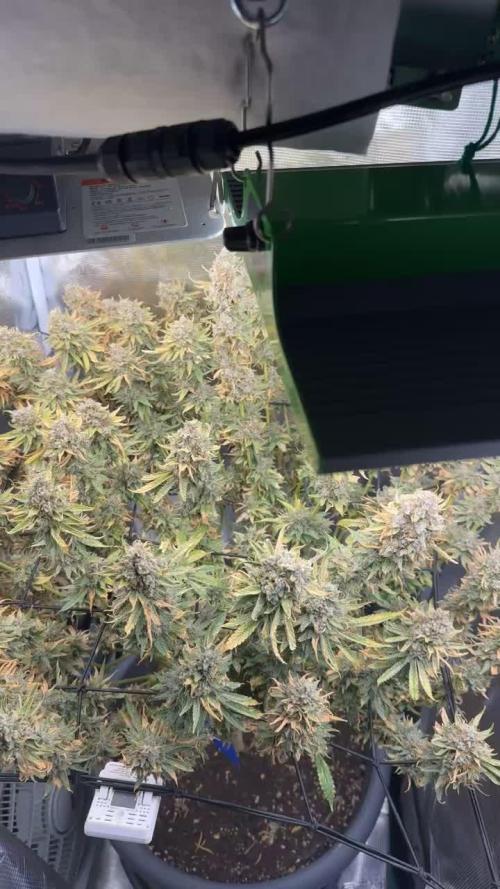The Grow Awards 2026 🏆 

























Likes
Comments
Share


@StonedFarm
Follow
09/28/24 - Purple Punch 👊 & Green Crack 💚
Both these girls will have the ☀️ today, and tomorrow will get a feeding with the
09/29/24 - Purple Punch 👊 - Green Crack 💚
Both these girls got the dunk, and runoffs are perfect. 1000-1100 PPM runoffs, with 6.4 Green Crack, and 6.5 Purple Punch
Likes
2
Share


@Cn0te
Follow
Been in 12/12 for 1.5 weeks.
Wound up with 6 healthy looking females. 3 Girl Scout Cookie, 3 Lemon Sour Diesel. Still monitoring for male genetics, but so far so good.
Pistils weren't showing on the two I pulled, but weren't clearly male either. Grow room was getting crowded though, so I pulled the two that weren't clearly female.
Likes
13
Share


@WhackyTobaccy
Follow
So far so good. Like how big the leaves are getting. Slowly introducing more nutrients to these babies.
We've ordered a bag of CO2. Can't wait till it arrives. 🙏🤗
Day09 - Foliar spray. Nothing special. So far so good.
Day11(May06) all good so far. Both plays at 7cm tall.
Day13(May-08) did LST on both plants. So far so good.
Day-14(May-09) nothing to report.
Additional Notes:
- Making 1 liter batches with water which i give every day about 100ml.
- Using Alg-A-Mic 0.5 ml/l as a foliar spray.
Likes
3
Share


@Aut0mac24
Follow
I cut of some of the bigger leaves off as they we're creating a lot of darkness inside the plant.
Likes
3
Share


@Luv2Grow
Follow
Day 71 - Starting off week 11 with 2 gallons of water and 15ML of Cal-Mag. She’s definitely starting to beef up and getting pretty frosty and smelly now. Had to remove a few more leaves towards the bottom that we’re dying off and just tucked the rest once she was out back in the tent.
Day 72 - Not much happening right now, she’ll definitely be ready for water again tomorrow and tomorrow’s dose will be with nutrients. Just kinda fluffed her up a bit and tucked the leaves before putting her back into the tent.
Day 73 - She was dried up again today so she got 2 more gallons of water and nutes. The smell is really starting to get strong, like a sweet funky cheese.
Day 74 - Nothing new today, just took her out for new pictures and out her back in the tent and tucked some leaves. Noticing a two branches that just aren’t getting much light so thinking about chopping them off but not sure because it could be too late to do it and don’t want her to be stunted this late into the grow.
Day 76 - All looking good now, she was a bit droopy today because I didn’t get a chance to water her yesterday but within an hour of getting water today, she perked right up.
Likes
4
Share


@sjrseid
Follow
The featured time-lapse is from week 0 to week 5. The camera will be fixed; I couldn't hang it up earlier. Some light LST was required for overall light penetration. Final week of vegetative state before the stretch and pre-flower!
Likes
10
Share


@NewNewbie
Follow
Chop Day! After recovering, i noticed she had the leaves closest to the fan drying up. I think since she lost most of her leaves, it was too windy and she got windburned. Considering her over all bad shape i decided to go for an earlyer chop then usual, but all trichomes seem to be milky, with just a few brown ones. Over all, this grow was filled with problems and fuckups. Many things were learned :) May the next one be better!
Processing
Likes
12
Share


@Piablo
Follow
Lessons learned from week 1 of my first grow so far:
the best watering solution I found so far is a mix of distilled water from the store and filtered tap water. with a final ph of 6 and ppm of 20-40.
a little ph buffer goes a bloody long way. Use with caution.
performing tasks like mixing solution and potting a germinated seed are best performed without a phone (camera) in one hand.
the seed germinated within 24 hours using paper towels. I planted after 36 hours.
After 24 hours of potting, the stem was already shooting up, and I turned on the lights, set to an 18 hour schedule. I wasn't quite ready for this, so it took me some time to research and get the desired humidity and temperature.
At this point I added more nutrient in even quantities of FloraGro, FloraMicro, and FloraBloom, according to instructions. Perhaps a little early though, although after just one 18 hour light cycle this plant is shooting up like a rocket and showing leaves.
I bought a fan for the inside of the tent and propped it up on a box, and a humidifier to bring the humidity from 40-50% to around 70%.
Since it's a winter grow, I have to periodically increase the temperature to keep it at 25 °C. The intake fan, humidifier, and inside fan are significantly lowering the temperature. I'm also experimenting with finding the right humidifier settings since the humidity seems to increase a lot when the lights go out, and the machine is still new.
Likes
19
Share


@adam_pawloski87
Follow
Let’s go Day 46 from seed!! What a great week it’s been, girls structured up real nice veg has been huge for us, looking super healthy an catching a nice smell ! This will be the last week of feeding them the veg schedule, next we will be dipping right into bloom, starting Monday yall We will be in full bloom !! Can’t wait to watch these ladies stack over the next few weeks 😍! I hope you all enjoy an have an amazing productive day an week ! Peace love an positive vibes y’all Cheers 😶🌫️💨💨💨💨💨🤙🏻
Likes
8
Share


@ElchichodelaGrasa
Follow
Hemos terminado hoy de transplantar a la que va a ser su maceta definitiva y hoy se ha encendido por primera vez el armario aunque ayer ya teníamos transplantadas unas cuántas debido a la bombilla que utilizábamos (Se fundió :( ), de todas formas ha sido cambiada a una AUVL así que muy contento y con ganas de empezar a ver resultados.
Likes
16
Share


@Sethstover
Follow
Always used the least amount of calmag if this specific plant and it was always darker green than I'd like but that's jus the picky plant
Likes
18
Share


@berlinbeginner
Follow
i flipped them to flower. Noticed a bit of stretch which will probably continue for another two weeks. SD2 still looks light but i flipped them all anyway. Will see what happens
Likes
10
Share


@DeepRootsGrowTrees
Follow
APRICOT GORILLA AUTO /
GANJA FARMER
HARVEST WEEK
This lady produces golf sized trichome covered buds that had a sweet aroma to her. She's a nice smooth smoke not heavy at all light notes with this lady.
Thank you for stopping by and taking a look it's much appreciated!!
THANK YOU GANJA FARMER!!
APRICOT GORILLA AUTO /
GANJA FARMER

































